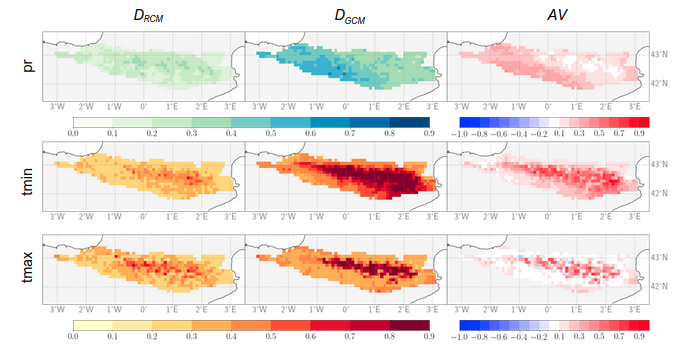BC3 research unveils comprehensive studies on climate impact in the Pyrenees, enhancing hydrological and climate modelling


Bilbao, Spain – July 29, 2024
BC3 has released a series of groundbreaking studies that provide new insights into the hydrological and climatic dynamics of the Pyrenees. These studies collectively emphasize the critical role of advanced modelling techniques in understanding and mitigating the impacts of climate change on mountain regions. The research, which has been published in the form of three scientific articles, combines scales ranging from the entire mountain region to the watershed level, providing an integrated perspective aimed at addressing the complexities of the Pyrenean region. A wide variety of data and methodologies have been used, including climate simulation products, hydrological modelling, and the application of machine learning techniques.
Mountains play a crucial role in supplying water for consumption, irrigation, and hydroelectric power but are highly vulnerable to climate change. The Pyrenees, a prime example, are experiencing significant changes in land-use practices, notably a shift towards increased forest cover. BC3’s latest research highlights how these changes, alongside climate variability, influence the region’s hydrological cycle.
Using the SWAT model, one study analyzed the hydrological impacts of land-use change and climate variability, revealing that these factors account for nearly equal parts of the observed decline in streamflow. Land-use changes contribute to 41.1% of this decline, with significant increases in flood frequency and magnitude due to climate variability. The SWAT model demonstrated a good performance, with R2 values of 0.75 and 0.55 for the validation period, indicating its effectiveness in capturing the hydrological dynamics of the Anduña River Basin.
Significantly, the study observed a significant positive trend in maximum and minimum temperatures during the summer months and identified a transformation in land use from pastures to forests. The findings underscore the importance of reforestation in mitigating some adverse effects and highlight the combined impact of climate variability and land-use changes on the region’s water regime.
“These results underscore the importance of responsible land use management to protect the hydrological cycle.” (Nerea Bilbao, BC3 researcher and lead author of the research).
Another study employed machine learning algorithms to construct Multi-Model Ensembles (MMEs) based on Regional Climate Models (RCMs) for the Esca River basin. This innovative approach enhances the accuracy of precipitation and temperature projections, significantly improving hydrological representation. By selecting seven top-performing RCMs, the study showcased notable improvements in precipitation representation on both annual and seasonal scales. Although temperature improvements were more subtle, the machine-learning-based MMEs yielded results that significantly outperformed simulations based on single RCMs and Simple Ensemble Means (SEMs).
The methodology’s application to climate projections under the RCP8.5 scenario provided more realistic information, reducing uncertainty in climate outputs for adaptation planning and basin-scale impact analyses. These advancements are particularly significant in the high mountain regions of the Pyrenees, where accurate climate projections are essential for effective climate change adaptation.
“The combination of climate simulations and machine learning algorithms demonstrates significant potential to enhance our understanding of climate change, especially in regions that are particularly challenging to model.” (Nerea Bilbao, BC3 researcher and lead author of the research).
Further advancing climate modelling, a third study assessed the added value of downscaling from Global Climate Models (GCMs) to Regional Climate Models (RCMs). The research demonstrated substantial improvements in capturing precipitation and temperature extremes in the Pyrenees, highlighting the benefits of dynamic downscaling. Using the CLIMPY observational database as a reference, the study found significant enhancements in reproducing mean precipitation across central and southwestern parts of the mountain range.
It also noted improved representation of mean maximum and minimum temperatures, particularly in higher elevations. However, challenges remain in accurately representing low precipitation rates and near-freezing temperatures, especially in the Mediterranean areas of the mountain range. The findings underscore the significant contributions of RCMs while also highlighting their limitations, essential for informed application in developing adaptation plans and risk management strategies.
“By being aware of the strengths and weaknesses of climate simulation products, we can use them more effectively and appropriately.” (Nerea Bilbao, BC3 researcher and lead author of the research).
These studies collectively provide essential data for policymakers and industry stakeholders, supporting sustainable water resource management and climate adaptation strategies in mountainous regions. The insights are particularly valuable for the International Civil Aviation Organization’s Committee on Aviation Environmental Protection (CAEP), aiding in the development of guidelines for estimating greenhouse gas emissions from sustainable aviation fuels.
Paper list:
- Multi-Model Ensemble Machine Learning Approaches to Project Climatic Scenarios in a River Basin in the Pyrenees https://link.springer.com/article/10.1007/s41748-024-00408-x
- Added value of EURO-CORDEX downscaling over the complex orography region of the Pyrenees https://link.springer.com/article/10.1007/s00382-024-07318-8
- Declining water resources in the Anduña River Basin of Western Pyrenees: Land abandonment or climate variability? https://www.sciencedirect.com/science/article/pii/S2214581824001198?via%3Dihub


